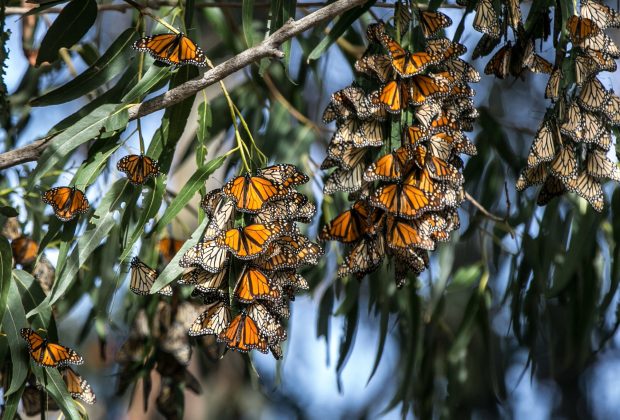“Something’s going on in early spring,” a professor said, and researchers are trying to solve the mystery.

Western monarch butterflies spend their winters in Pismo Beach and other sites on the central California coast. A few months later, they breed in the Central Valley and as far north and east as Idaho.
But where they go in between remains an open question.
Now, a group of researchers wants the public’s help to solve that mystery.
They would like anyone who spots a monarch north of Santa Barbara this spring to snap a quick picture. The researchers — from Washington State University, Tufts University, the nonprofit Xerces Society for Invertebrate Conservation, and the University of California, Santa Cruz — need photographic evidence, a date and a location to confirm where the monarchs might be living. (Photos and information can be emailed to monarchmystery@wsu.edu or uploaded on the iNaturalist app.)
“Something’s going on in early spring,” said Cheryl Schultz, a professor at Washington State University in Vancouver. Researchers know that winter survival isn’t the issue in the short-term, she said.
But they don’t know whether the monarchs are not making it to breeding sites, not finding plants to nourish them along the way, or not able to find mates.
The Western monarch population, which lives west of the Rocky Mountains, stood in the millions in the 1980s. In 2017, an annual count found 200,000 butterflies. In 2018, the tally fell to about 30,000 — a figure that held steady last year, said Elizabeth Crone, a biology professor at Tufts University in Medford, Mass.
The monarch’s decline is part of a larger trend among dozens of butterfly species in the West, including creatures with names like field crescents, large marbles and Nevada skippers, said Matt Forister, an insect ecologist at the University of Nevada, Reno, whose conclusions are based on a nearly 50-year set of data compiled by Art Shapiro, a researcher at the University of California, Davis. “The monarch is very clearly part of a larger decline of butterflies in the West.”
Research pins the loss of Western butterflies on a variety of factors, including development, climate change, farming practices and the widespread use of pesticides by farmers, and on home and business lawns, Dr. Forister said.

Another factor, she said: Some homeowners, eager to attract monarchs, have planted tropical milkweed. Although the butterflies will feed on them, these plants tend to spread disease, because they don’t drop their leaves, Dr. Schultz said, which may be contributing to the declining monarch population. Native milkweed supports the population without this risk, she said.
Climate change also plays a role in the challenges facing monarchs and other butterflies, said Chip Taylor, a professor emeritus at the University of Kansas, who also directs Monarch Watch, a network of students, teachers, volunteers and researchers. Temperatures in the Western monarch’s overwintering sites along the coast now average 2 degrees higher in January and February than they did just two decades ago — the highest rate of increase outside Alaska, he said.
Western monarchs are quite similar to their Eastern cousins, just a bit smaller and darker, Dr. Crone said. But they have a distinct migratory pattern.
While the Eastern monarchs migrate from Mexico to as far away as New England and Southern Canada, the Western ones mostly remain in Southern California or migrate from the mid-coast up as far as British Columbia and as far east as the Rockies, Dr. Schultz said.
In the last couple of years, she said, the range of their breeding grounds has been contracting. The butterflies are going inland as far as Nevada, but they’re not making it as far as Washington State anymore.
Like other insects, butterflies often have good years and bad. “Butterfly populations are bouncy,” Dr. Schultz said. “While we think the situation right now is very concerning, we do think there’s a lot of potential to turn it around.
Dr. Schultz said she saw two reasons for hope. First, the population decline seen in 2017-18 wasn’t repeated last year. And second, she’s seen butterfly populations rebound before.
When she started working to help preserve the Fender’s blue butterfly in the early 1990s, there were only about 1,500 of the insects left in the Willamette Valley in Oregon. This year, thanks to collaborative efforts by citizens, farmers, private landowners and government, there were almost 25,000.
“That’s the kind of commitment that gives me both optimism and the sense that we can do this,” Dr. Schultz said. “My hope with Western monarchs is we can bring the population back up.”

In other butterfly-related news, a study published Jan. 28 in Nature Communications provided new insights into how butterflies keep their wings from overheating in the sun.
Previous temperature research had focused on the thorax, because butterflies cannot fly if their thorax is too cold. But their thin wings build up heat quickly, and the new research examined how that heat is dispersed so it does not kill the fragile living cells in the wing.
Using imaging techniques, researchers from Harvard and Columbia universities found specialized scales on the living parts of the wing that have tiny, intricate structures allowing them to dissipate heat. This enhanced thermal radiation allows the parts of the wing with living cells to remain cooler than other parts of the wing, by as much as 10 to 15 degrees Celsius.
“There’s incredible fine-tuning to keep the wing cool, especially the living parts of the wings,” said Naomi Pierce, a butterfly expert and biology professor at Harvard, who helped lead the research. “I’ve found it really interesting and surprising.”
These structures have already been mimicked in paint that can disperse heat and reduce energy costs, Dr. Pierce said.
Dr. Taylor said the research opened entirely new areas of butterfly research and “understanding of how this group of organisms has to deal with incident radiation.”
Source: Karen Weintraub ~ The New York Times ~ March 20, 2020







